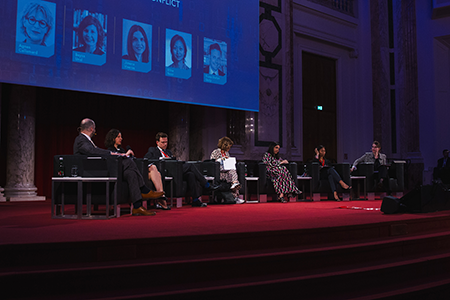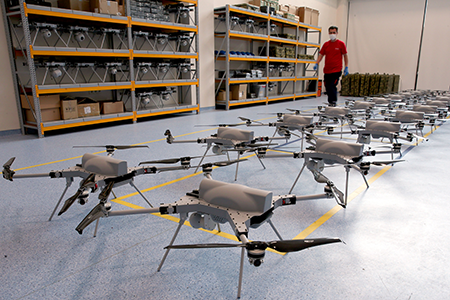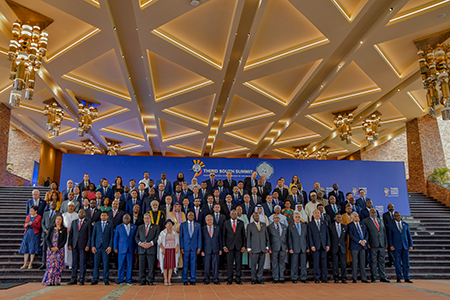“For 50 years, the Arms Control Association has educated citizens around the world to help create broad support for U.S.-led arms control and nonproliferation achievements.”
The Global South and Autonomous Weapons Controls
November 2024
By Alexander Hoppenbrouwers
Since the start of the war in Gaza, an Israeli artificial intelligence (AI) system called Lavender has assisted the Israel Defense Forces target selection. Describing Lavender’s approach to this assignment, an Israeli intelligence officer said, “The machine did it coldly. And that made it easier.”1

The Lavender system is a prime example of what many experts are warning against: a developed economy using its technological advantages by deploying AI-powered weapons systems against a Global South adversary, thus expanding the scale on which it can unleash destruction. Analysts often point to this scenario to suggest that Global South countries should be united in aiming to restrict autonomous weapons systems to the greatest extent possible.2
Ongoing diplomatic efforts present a different picture. Several Global South countries are hesitant to restrict the use of autonomous weapons systems or even oppose outright legally binding rules to regulate them. An analysis of their positions suggests that the specific geopolitical situation of these countries is a stronger determinant of their approach to autonomous weapons systems than their status as part of the Global South. Understanding the motivations of these countries is not only crucial for diplomats working on the autonomous weapons topic, but it also provides insight into how international negotiations might evolve in the coming years. This evolution will have important ramifications for how wars in the 21st century will be fought.
International discussions on autonomous weapons systems have been held mainly in the Convention on Certain Conventional Weapons group of governmental experts on autonomous weapons systems. Precursors of this group have discussed autonomous weapons systems since 2014. The group has struggled to make progress due to its consensus-based decision-making, allowing individual states to block any decisions. Action has shifted therefore to new venues: for instance, Austria has spearheaded efforts to move discussions on autonomous weapons systems to the UN General Assembly.3
At the same time, several crucial stakeholders have refused any move away from the experts group as the appropriate forum for these discussions. Although not all Global South states are members of the experts group, several Global South states have taken prominent roles in that process.

Small Global South states tend to consider autonomous weapons systems fundamentally dangerous from legal, humanitarian, ethical, and security standpoints. Calls to start negotiating a strict, legally binding instrument to prohibit some autonomous weapons systems and regulate others as soon as possible are made regularly by large groups of these states. A group of mainly smaller Global South states submitted a draft legally binding protocol during the 2023 session of the experts group,4 and a similar group called for the formulation of elements of a legally binding instrument in its 2024 session.5 At times, such states also explicitly refer to technological differences between the Global South and Global North, called the “digital divide,” for instance when a Palestinian delegation warned that AI-powered systems are likely “to be tested on populations of the Global South.”6
Major powers take nearly the opposite approach. India has stated that existing international law is a sufficient framework to deal with autonomous weapons systems.7 It is already using AI technologies to power swarms of drones, as well as to support intelligence operations.8 China has stated that it supports a ban on autonomous weapons systems, but its description of these systems is so narrow that it excludes those likely to be used on the battlefield.9 This framing allows China to form a unified rhetorical front with smaller Global South countries while avoiding steps toward an effective instrument to ban autonomous weapons systems. Similar to India, China is developing autonomous vehicles and exploring the use of AI technologies to support its weapons systems.10
Middle powers present a more varied picture. As a diplomat from the Philippines involved in the 2023 session of the experts group explained, “While smaller states tend to articulate progressive and principled positions in a more general sense, middle powers tend to have more nuanced positions.”11 Several of these middle states, especially those such as Brazil and Mexico that are further removed from geopolitical hotspots where autonomous weapons systems may be used, have joined the criticisms of these weapons voiced by the smaller Global South cohort.
States closer to conflict areas tend to reject the view that autonomous weapons systems are fundamentally dangerous. Turkey, for instance, does not support the development of new international law related to autonomous weapons systems. It also has pointed to possible positive effects that AI systems could have in decision-making during conflicts.12
Perhaps the best example of the complicated position of some middle Global South powers is Pakistan. Although Islamabad has expressed support for the development of legal restrictions on autonomous weapons systems, its statements frequently accord particular importance to risks related to strategic stability. In 2023, Pakistan stated in the experts group, “Mitigating risks from a humanitarian perspective is well placed. However, they alone cannot be a substitute to recommendations on addressing the security dimension.”13 Yet, Pakistan also is earmarking funds for the use of AI technologies and machine learning by its military.14
This example shows how geopolitics shapes calculations. The risk of conflict escalation is a major concern, and if a legally binding instrument to regulate autonomous weapons systems is not forthcoming, Pakistan prefers to match the autonomous weapons abilities of India, its geopolitical rival.
The idea that the Global South uniformly takes a principled stance in opposition to autonomous weapons systems is thus wrong. Admittedly, opposition to these systems is popular in the Global South. The 120-member Non-Aligned Movement (NAM), for instance, submitted a working paper to the experts group in 2022 that calls for a legally binding instrument on autonomous weapons systems and makes reference to morality and ethics.15 At the same time, the Philippine diplomat stressed that “NAM has not been very active in the [experts group] due to differences in positions among its members.”16

Other Global South states have pushed back against autonomous weapons systems regulations. For instance, the majority of states that voted against or abstained from voting on a 2023 UN General Assembly resolution calling for intensified efforts to regulate autonomous weapons systems were from the Global South.17 Understanding this dynamic requires analyzing the specific geopolitical and technological factors affecting the potential exposure of Global South countries to autonomous weapons systems.
For one thing, cross-regional coalitions are likely to play an important role on specific issues when positions of states from different regions converge. This is already visible, even for issues that at first glance may seem closely tied to a specific region’s interests. For example, the only working paper that made a mention of the digital divide during the 2024 session of the experts group was submitted by six Global North and four Global South countries.18 Figuring out how to build and enlarge such cross-regional coalitions will be crucial for countries to further their positions.
Division within the Global South makes it more difficult for those states favoring strict, legally binding autonomous weapons systems regulation to achieve consensus within the experts group. The group’s current slow pace of progress already has been decried by most participants. The lack of a unified Global South front lessens pressure on the experts group as a whole and is one factor preventing quicker and more effective decision-making.
A gradual shift in Global South positions toward greater acceptance of autonomous weapons systems may be possible. Middle-sized Global South states that are closer to conflict areas, such as the Middle East, tend to be less critical of autonomous weapons systems due to their interest in acquiring them. Because legal prohibitions and regulation of autonomous weapons systems are not forthcoming and the international security environment is becoming more fragile, Global South states increasingly may see a need to acquire autonomous weapons systems as their geopolitical adversaries do the same. This would result in a shift in their positions in the experts group.
Rapid action therefore will be needed if progress is to be made on regulating and prohibiting autonomous weapons systems. In a report released on August 6, UN Secretary-General António Guterres reaffirmed the need for urgent action to preserve human control over the use of lethal autonomous weapons systems.19
Recent efforts to move discussions from the experts group to the UN General Assembly could be promising for the Global South, which is better represented in the General Assembly than the experts group. Even if some Global South states did not support the Austrian initiative, the fact that the General Assembly operates by majority vote rather than consensus means that states that oppose strict, legally binding autonomous weapons systems regulation will be unable to block the Global South’s majority support for strict measures on autonomous weapons systems.
Regional initiatives can complement global discussions. In the Belén Communiqué, the CARICOM Declaration on Autonomous Weapons Systems, and the Freetown Communiqué, regional groupings in the Global South committed to work toward new international law regulating autonomous weapons systems.20 Such regional initiatives make it more difficult for states to change their positions on autonomous weapons systems if their geopolitical situation changes and put pressure on all states in these regions to commit themselves to decisive action. Similar efforts could go further by including some legal measures. For example, already existing nuclear-weapon-free zones could be the inspiration for the creation of zones free of autonomous weapons systems.
In the Gaza conflict, the Lavender system shows the frightening potential of warfare in the 21st century. Many Global South countries have recognized this and have committed to work toward effective autonomous weapons systems regulation and prohibitions. Others, however, prefer to acquire Lavender-like systems of their own. World leaders must act quickly at the regional and global levels to ensure that the full potential of these systems is not unleashed on battlefields inside and outside of the Global South.
ENDNOTES
1. Bethan McKernan and Harry Davies, “‘The Machine Did It Coldly’: Israel Used AI to Identify 37,000 Hamas Targets,” The Guardian, April 3, 2024.
2. For instance, see Women’s International League for Peace and Freedom, “Women’s International League for Peace and Freedom (WILPF) Submission to the UN Secretary-General’s Report on Autonomous Weapon Systems,” May 20, 2024, https://www.reachingcriticalwill.org/images/documents
/Publications/wilpf-submission-unsg-report-aws.pdf; Charlie Linney and Xiaomin Tang, “AI and Autonomous Weapons Systems: The Time for Action Is Now,” Saferworld, May 15, 2024, https://www.saferworld-global.org/resources/news-and-analysis/post/1037-ai-and-autonomous-weapons-systems-the-time-for-action-is-now.
3. UN General Assembly, “Lethal Autonomous Weapon Systems,” A/RES/78/241, December 28, 2023.
4. Convention on Prohibitions or Restrictions on the Use of Certain Conventional Weapons Which May Be Deemed to Be Excessively Injurious or to Have Indiscriminate Effects (CCW), “Draft Protocol on Autonomous Weapon Systems (Protocol VI),” CCW/GGE.1/2023/WP.6, May 11, 2023.
5. CCW, “Compilation of Replies Received to the Chair’s Guiding Questions,” CCW/GGE.1/2024/CRP.1, March 1, 2024.
6. State of Palestine, Statement to the Vienna Conference on Autonomous Weapons Systems, n.d., https://www.bmeia.gv.at/fileadmin/user_upload/Zentrale/Aussenpolitik/Abruestung/AWS_2024/Statements/State_of_Palestine_Statement.pdf.
7. Tejas Bharadwaj and Charukeshi Bhatt, “India’s Normative Stance on Lethal Autonomous Weapons Systems,” Carnegie Endowment for International Peace, February 26, 2024, https://carnegieendowment.org/posts/2024/02/indias-normative-stance-on-lethal-autonomous-weapons-systems?lang=en.
8. Antoine Levesques, “Early Steps in India’s Use of AI for Defence,” International Institute for Strategic Studies, January 18, 2024, https://www.iiss.org/online-analysis/online-analysis/2024/01/early-steps-in-indias-use-of-ai-for-defence/.
9. Kelley M. Sayler, “International Discussions Concerning Lethal Autonomous Weapon Systems,” CRS In Focus, No. IF11294, February 14, 2023.
10. Sam Bresnick, “China Bets Big on Military AI,” Center for European Policy Analysis, April 3, 2024, https://cepa.org/article/china-bets-big-on-military-ai/.
11. Philippine diplomat, interview with author, Vienna, July 10, 2024.
12. Republic of Türkiye, General statement to the group of governmental experts on lethal autonomous weapons systems, n.d., https://docs-library.unoda.org/Convention_on_Certain_Conventional_Weapons_-Group_of_Governmental_Experts_on_Lethal_Autonomous_Weapons_Systems_(2024)/T
%C3%BCrkiye-CCW_LAWS_GGE-04032024.pdf (meeting held March 4-8, 2024).
13. Permanent Mission of Pakistan to the United Nations Geneva, “Remarks by Ambassador Zaman Mehdi, Deputy Permanent Representative of Pakistan at the Meeting of Group of Governmental Experts (GGE) on Lethal Autonomous Weapons Systems (LAWS),” May 15, 2023, https://docs-library.unoda.org/Convention_on_Certain_Conventional_Weapons_-Group_of_Governmental_Experts
_on_Lethal_Autonomous_Weapons_Systems_(2023)/Statement_of_Pakistan_at_GGE_(15
_May_2023).pdf.
14. Zohaib Altaf and Nimrah Javed, “The Militarization of AI in South Asia,” South Asian Voices, January 16, 2024, https://southasianvoices.org/sec-c-pk-r-militarization-of-ai-01-16-2024/.
15. Non-Aligned Movement, Geneva Chapter, “Working Paper by the Bolivarian Republic of Venezuela on Behalf of the Non-Aligned Movement (NAM) and Other States Parties to the Convention on Certain Conventional Weapons (CCW),” March 7, 2022, https://documents.unoda.org/wp-content/uploads/2022/08/WP-NAM.pdf.
16. Philippine diplomat, interview with author, Vienna, July 10, 2024.
17. UN Press, “First Committee Approves New Resolution on Lethal Autonomous Weapons, as Speaker Warns ‘An Algorithm Must Not Be in Full Control of Decisions Involving Killing,’” GA/DIS/3731, November 1, 2023, https://press.un.org/en/2023/gadis3731.doc.htm.
18. CCW, “Addressing Bias in Autonomous Weapons,” CCW/GGE.1/2024/WP.5, March 8, 2024.
19. UN General Assembly, “Lethal Autonomous Weapons Systems: Report of the Secretary-General,” A/79/88, July 1, 2024.
20. Latin American and the Caribbean Conference of Social and Humanitarian Impact of Autonomous Weapons, Communiqué, February 24, 2023, https://conferenciaawscostarica2023.com/wp-content
/uploads/2023/02/EN-Communique-of-La-Ribera-de-Belen-Costa-Rica-February-23-24
-2023..pdf; Caribbean Community, “CARICOM Declaration on Autonomous Weapons Systems,” n.d., https://www.caricom-aws2023.com/_files/ugd/b69acc_4d08748208734b3ba849a4cb257ae189.pdf; Regional Conference on the Peace and Security Aspects of Autonomous Weapons Systems: An ECOWAS Perspective, Communiqué, April 18, 2023, https://article36.org/wp-content/uploads/2024/04/Freetown-Communique-18-April-2024-English.pdf.
Alexander Hoppenbrouwers, a researcher on nonproliferation and arms control issues, has completed internships with the Vienna Center for Disarmament and Non-Proliferation, the Dutch Foreign Ministry, and the EU delegation to the United Nations in Geneva.
